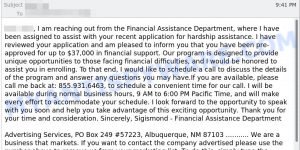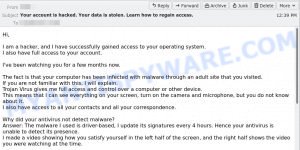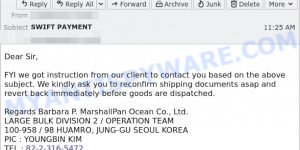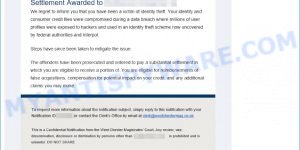Have you recently received an email with the headline ‘Your account was hacked‘? You’re not alone. Over the past months, there’s been a significant uptick in a type of email scam, where crafty fraudsters claim they’ve compromised your account and captured compromising materials. These alarming emails often demand payments in Bitcoin and use a slew of technical terms like ‘Remote Desktop Protocols (RDP)’ and ‘keyloggers’ to sound credible.
It’s a Scam. These emails are typically sent out in bulk, targeting large numbers of people. The scammer is hoping that by casting a wide net, they’ll be able to find a few individuals who are frightened enough to pay. They often don’t have any actual compromising material.
Remember that the goal of such emails is to exploit your fears. If you ever receive a suspicious email, never act immediately. In this article, we’ll delve into the details of this scam, how it works, and most importantly, what you should do if you receive such an email.
Here’s an example of the “Your account was hacked” email:
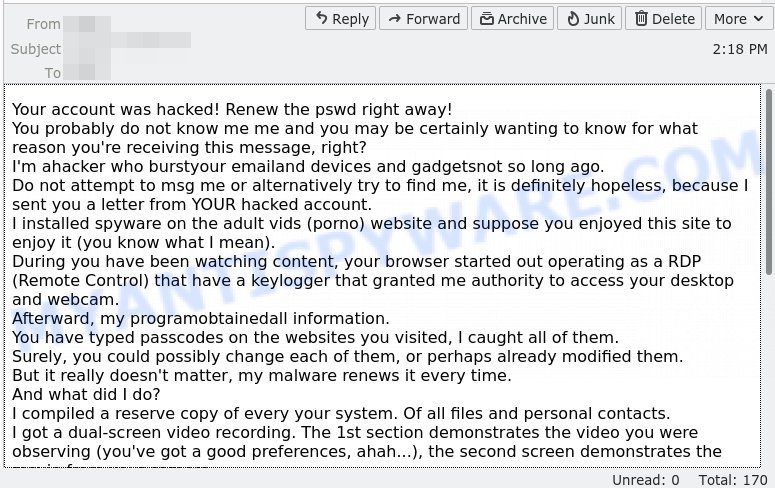
Table of Contents
Is this a scam email?
YES. The “Your Account Was Hacked” email is a phishing scam that preys on fear and blackmail tactics. It begins with a message informing you that your account has been compromised by a supposed hacker. The email asserts that the hacker has control of your computer, webcam, and personal information. The email threatens to expose sensitive content, including video footage of you, unless you comply with the scammer’s demands. These demands usually involve sending a ransom payment in Bitcoin to a specified wallet address within a given timeframe.
Red-Flags Indicating It’s a Scam:
- Threatening Language: The email begins with alarming statements, such as claiming that your account has been hacked. It may even suggest that you’re being watched.
- Spyware Claim: The scammer alleges that they have installed spyware on adult content websites and that they’ve captured your activities.
- Video Threat: The scammer claims to have recorded you through your webcam while you were browsing the adult content website, attempting to make you believe they have compromising footage.
- Bitcoin Wallet Address: The use of Bitcoin is a way for scammers to try to receive money anonymously. It’s worth noting that once you send Bitcoin, it’s almost impossible to get it back.
- Short Deadline: The email often sets a tight deadline, usually 48 hours, for you to comply with their demands.
- Facebook Pixel Mention: The mention of “Facebook pixel” is misleading. While pixels can track email opens, they can’t trace deeper actions like the reading of a message or actions within a computer.
- No Mention of Specific Personal Details: Aside from the generic “hacked content”, they won’t mention any specific personal information about you, like your full name, address, or other data, which a genuine hacker would probably use to prove their claims.
In summary, 🚫 If you encounter such emails, it’s crucial to remain calm and not engage with the sender. Remember, these are empty threats designed to exploit your fears. It’s always best to protect your online presence and be wary of such tactics. 🛡️ Always ensure the safety of your devices, change passwords regularly, and be cautious about sharing personal information online.
How the scam works
Initially, you might wonder, “Where did they get my email address?” The answer lies in the numerous data breaches and online lists circulating on the dark web. Scammers can acquire vast lists of email addresses, sometimes coupled with other personal information, from various sources. They target these addresses in hopes that at least a few individuals will respond.
The ambiguous threats are their next weapon. 🚫 With a broad approach, they send out countless emails, betting on the chance that some recipients might be alarmed. They intentionally avoid mentioning any specific website or source of their alleged information, leading you to wonder, “Could there be any truth to this?”
Their narrative then deepens with a fictitious tale 🎭 of supposed system infiltration. They spin stories of having implanted malicious software on your device, insinuating they have access to your every move. Yet, conspicuously, they offer no real evidence to substantiate their claims.
In the final step of their ploy, they demand a ransom. 💰 Emphasizing quick payment, often via hard-to-trace channels like Bitcoin, is key to their strategy. By imposing a stringent timeframe, they hope to pressure you into acting impulsively, driven by fear and uncertainty.
The email read as follows:
Your account was hacked! Renew the pswd right away!
You probably do not know me me and you may be certainly wanting to know for what reason you’re receiving this message, right?
I’m ahacker who burstyour emailand devices and gadgetsnot so long ago.
Do not attempt to msg me or alternatively try to find me, it is definitely hopeless, because I sent you a letter from YOUR hacked account.
I installed spyware on the adult vids (porno) website and suppose you enjoyed this site to enjoy it (you know what I mean).
During you have been watching content, your browser started out operating as a RDP (Remote Control) that have a keylogger that granted me authority to access your desktop and webcam.
Afterward, my programobtainedall information.
You have typed passcodes on the websites you visited, I caught all of them.
Surely, you could possibly change each of them, or perhaps already modified them.
But it really doesn’t matter, my malware renews it every time.
And what did I do?
I compiled a reserve copy of every your system. Of all files and personal contacts.
I got a dual-screen video recording. The 1st section demonstrates the video you were observing (you’ve got a good preferences, ahah…), the second screen demonstrates the movie from your camera.
What should you do?
Great, in my opinion, 1000 USD is basically a reasonable amount of money for this little riddle. You’ll do the deposit by bitcoins (in case you don’t understand this, go searching “how to purchase bitcoin” in any search engine).
My bitcoin wallet address:
1DyiDqXUQ44qbnuBxARp5Q2Q2j6pvXZAyQ
(It is cAsE sensitive, so just copy and paste it).
Warning:
You will have 48 hours to make the payment. (I built in an unique pixel to this message, and right now I understand that you’ve read through this email).
To tracethe reading of a messageand the actionsin it, I utilizea Facebook pixel. Thanks to them. (Everything thatcan be usedfor the authorities should helpus.)If I fail to get bitcoins, I will immediately offer your videofile to each of your contacts, including family members, colleagues, and so forth?
All in all, this scam uses tricks to make you scared and rushed. If you receive an email like this, do not engage with the scammer and do not send any money. Instead, delete the email and report it to the relevant authorities. It is also important to ensure that your computer has up-to-date anti-virus software and that you use strong, unique passwords for all of your accounts to reduce the likelihood of falling victim to scams like this.
Examples of such scams
The “Your account was hacked” email scam is just one of the many deceptive schemes that prey on individuals’ fears and exploit their privacy concerns. Unfortunately, this type of scam is not unique, and there are various similar scams circulating online.
By examining these examples, you can better recognize the warning signs and arm yurself with knowledge to avoid becoming victims of fraudulent schemes. Take a closer look at the following scams: I RECORDED YOU Email Scam, Your Private Information has been Stolen Email Scam, and I am a professional hacker EMAIL SCAM and let’s learn how to safeguard ourselves from their deceitful tactics. Remember, knowledge is power.
- Financial Assistance Department Email Scam
- Geek Squad Email Scam (May 2023)
- Your account is hacked. Your data is stolen. Email Scam
- Reconfirm Shipping Documents Scam email
- Cash Settlement Awarded Email Scam
Should you pay?
No, you should not pay the ransom demanded by the scammer. Remember that this is a scam and paying the ransom will only encourage the scammer to continue their criminal activities! Additionally, paying the ransom can make you a target for future scams. It is important to stay vigilant and protect your personal information from such scams by using strong and unique passwords, enabling two-factor authentication, and regularly updating your computer’s security software. If you receive such an email, it is best to report it to the authorities and your email provider.
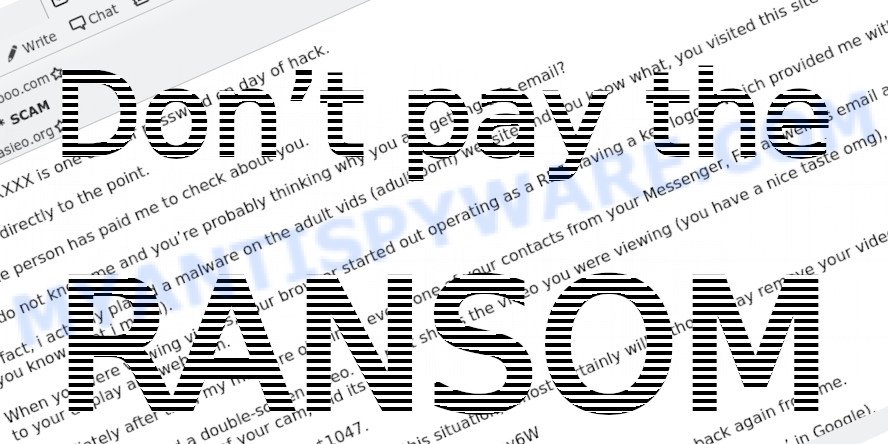
What to Do if You Receive the Email
Receiving the “‘Your account was hacked'” email can be deeply unsettling, but with the right steps, you can ensure safety and peace of mind.

Here’s a specific guide on handling this scam:
Begin by reminding yourself to stay calm. The email is crafted to elicit panic, pushing recipients into rash decisions. Recognize its true nature—a manipulative attempt to exploit fear.
Resist any impulses to pay. Even if you’re tempted to make the problem go away, understand that payment doesn’t guarantee safety. It merely emboldens the scammer, possibly marking you as an easy target for future deceptions.
Do not engage with the scammer. Replying or trying to open a dialogue can inadvertently give away more information, or signal that your email is active, making you a prime candidate for further scams.
Seeing a familiar password can be particularly jarring. If the scam email mentions a password you recognize, it’s essential to check its source. Use services like haveibeenpwned.com to see if your email or credentials have been compromised in any past data breaches.
Subsequent to that, update your passwords. Always choose strong, unique combinations and activate two-factor authentication on platforms that support it.
As a precaution, run a comprehensive security scan on your device. While the scam email’s claims about malware are usually baseless, this step ensures your system remains clean and threat-free.
Report the email to relevant authorities (e.g., FTC). Sharing details with your local law enforcement or cybercrime units can contribute to ongoing investigations and aid in the crackdown on such malicious activities.
Lastly, spread awareness. Inform friends, colleagues, and family about the scam, equipping them with the knowledge to recognize and sidestep such threats. Knowledge, shared and acted upon, diminishes the effectiveness of these scams, making the digital world a bit safer for everyone.
Threat Summary
| Name | ‘Your account was hacked’ |
| Type | Phishing/Sextortion |
| Ransom amount | $1000 USD (in Bitcoin equivalent) |
| Bitcoin Address | 3Qv9HRnPyie4b8nYeUp1Sp7Xcx8i28HvQg, 1DyiDqXUQ44qbnuBxARp5Q2Q2j6pvXZAyQ, 17qQSJatXXj5DnjMLjNGXx9BT7NUhqimRx, 15LZuFSVyDAoaNLtbh4ru7ZQWvZxEosCaf, 18DGKAQ3gHQVmPHPVyLvBGsCoX1d4G8yfq, 1JRfE57ZF8Eaqa7DktHmVCoAneA8q4fpP2, 1LthzYVB7jrYFPnJHDLriDnxk4BJ4Ch2jf, 1GXBRWZaTqTEvxY2NzfdrMwYbPHqfWNNYE, 14GHLvKaXSNtDTkshZi5j8uUo3mFtJ52FN, 19SDJp3rdgU99sadqEb437b1qAynsCg9r8, 1LWbhU7623zZjLHTnfTRyrcqbRnXoVKaBd, 1GVgsTh6j1oh5PUksWQDdiChtsRiWwkR6Q, 14dM8NWRhdzKixe3hcvY6HfQGcjt736Gkc, 1FUieDeAPMpTpz67aKfr1jsWXmJfvQ6V8w, 1CUmFahadM9fmENHcdepbwSENEdmqh7VeF, 19Bk81t5nG8DZJSaJB6xqgvqfs1pCeF4KS, 1Cboy74YFQy1pLJTRrnibYfqiVo3FXv9fe, 1LP5g9uxYdqkTGZfgjRU9dFbY3pra3BaPw, 1EcoMxqqevYgoK6syi3TD4mTaSJGYLQbGw, 1Jo478RY2qC8vZ1cxSmk2WFjq5j9bpfDuv |
| Fake Claims | Compromised data, webcam access, malware/backdoor installed |
| Damage | Psychological distress, potential financial loss if ransom is paid |
| Distribution | Mass emailing, likely from a purchased or hacked email list |
| Tactics | Fear induction, urgency, deception |
| Variations | Different ransom amounts, varying email content, alternative cryptocurrencies for payment |
| Prevention Tips | Use strong, unique passwords; enable two-factor authentication; be skeptical of unsolicited emails; never pay ransoms |
| Reporting Info | Forward to the Anti-Phishing Working Group at reportphishing@apwg.org; Report the scam to relevant authorities (e.g., FTC); Share information about the scam with friends and family to raise awareness; Monitor online accounts for any suspicious activity |
Conclusion
The ‘Your account was hacked’ email scam shows how cybercriminals try to scare people into giving them money. They do things like pretending to send emails from your own address and making big claims without any real proof. The best way to deal with these scams is to understand how they work. Always be careful online, don’t make quick decisions based on these emails, and focus on keeping your information safe. If something sounds too alarming or too good to be true, it’s a good idea to double-check and not rush into any action.
